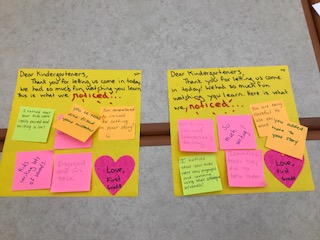Creating a student-centered classroom prioritizes student work, individuality, and engagement over elaborate decorations. By embracing ample wall space for student creations, teachers can foster a sense of ownership, promote collaboration, and celebrate student achievements.
Category: classroom environment
Looking Forward
The end of the school year is the perfect time to venture out of our classrooms and learn about what is happening in classrooms across our school buildings. These opportunities remind us that the work we do with writers is collective.
Three Ways to Find Joy & Keep Writing
We are now entering week seven in our school district. At the start of the year, there was much to think about and much to worry about. There were many questions to be answered and all of them seemed continuously uncertain. “We don’t know that yet” or “I’m not sure” were phrases that often seemed… Continue reading Three Ways to Find Joy & Keep Writing
Belief Statements: The Breadcrumbs of Teaching Near and Far
No matter where we gather to teach children, the values we have for children and education should not change.
Bringing Virtual Classrooms to Life
Is it possible to duplicate the live, in-person experiences? Of course not, but maybe some of you could feel the authenticity of a high-five or hug I'm sending your way. So let’s think about some ways to bring virtual classrooms to life, maybe thinking of it as duplicating some of the processes of your classroom in a virtual world.
Building a New Community
How are you finding ways to connect and bring a community of learners together?
Background Noise for Writing Workshop
How quiet is too quiet, when it comes to writing workshop?
Writing on the Walls
What we place on the walls of a classroom tells students, or any other person who enters the room, what is valued most, and what we should value most in our classrooms is student work.
Re-imagining Classroom Work Spaces: Reaching Your Writers
We cannot always afford to provide students everything we want to give them, but it’s important to find ways to give all kids what they need. It is possible to create a space with flexible seating options on a limited budget.
How to Deal with “Too Much” Energy in the Classroom + a Book Giveaway
Every writing workshop I've ever taught or consulted in has had at least one child who is in perpetual motion. Many times, that child is the kid who talks their classmates during independent writing time, interrupts their teacher during a writing conference, or cannot respect their peers' space in the meeting area. The first few weeks of school are the perfect time to begin conversations about living in a classroom community where all learners have different needs. Susan Verde, author of Unstoppable Me, chats with Stacey about the ways we can build classroom writing communities that welcome kids with who are often seen as having "too much" energy.
Revising the Classroom: Adventures in Flexible Seating
This year I had the opportunity to try out flexible seating with brand new furniture. It's been an adventure and I've learned many lessons along the way. What are your experiences with flexible seating?
Take a Tour of Your Own School with an Eye Toward Writing Workshop
When you have a chance, take a walk through the hallways of your own school. Try to see with fresh eyes. Pretend you are a visitor. Ask yourself: What kind of writing is on display? What kind of writing is not on display?If what we display in the hallways conveys a message about what we… Continue reading Take a Tour of Your Own School with an Eye Toward Writing Workshop













